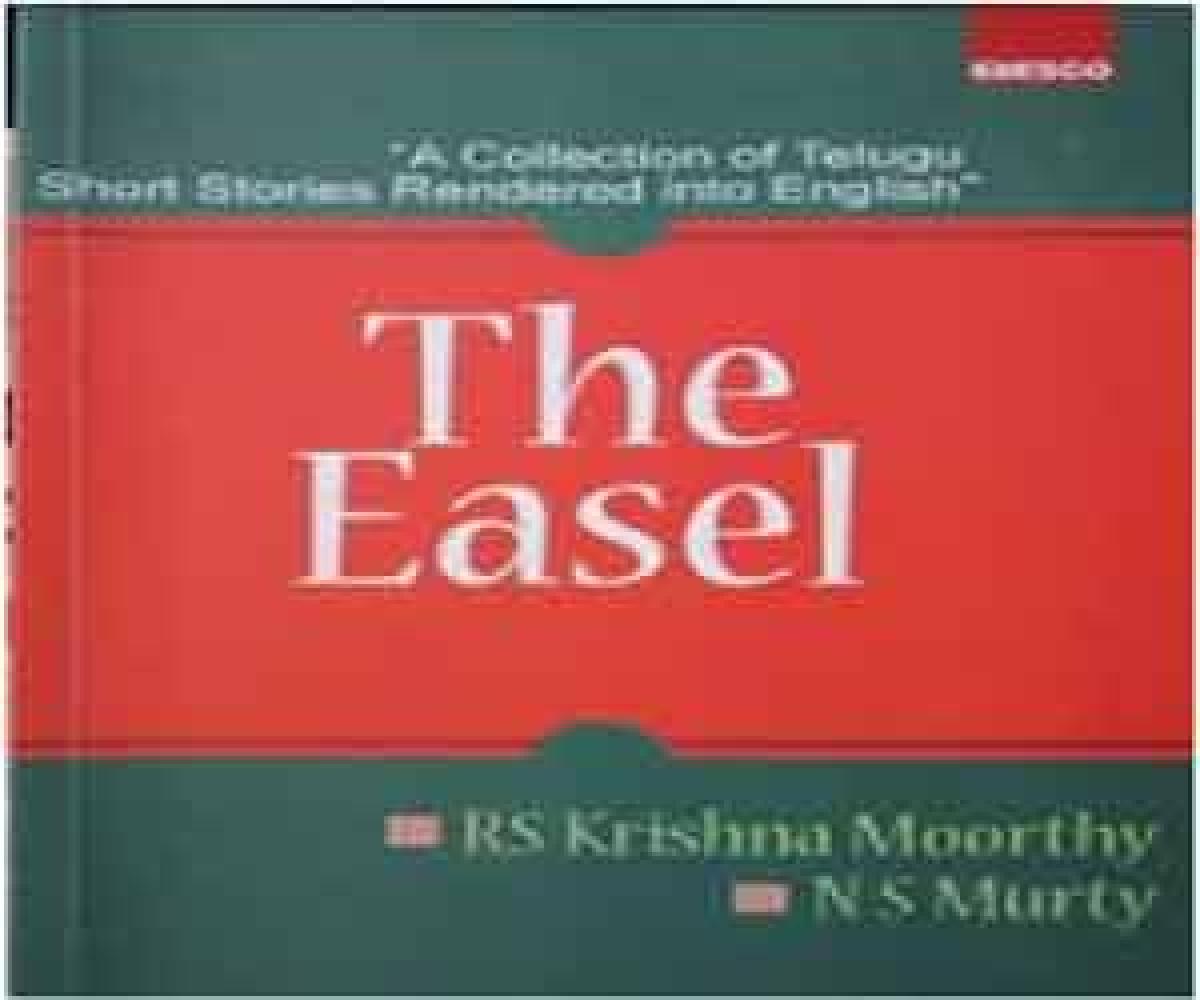Live
- CM meets Biswabhusan
- Lemon farmers reap big benefits in Vijayapura
- Waqf Board to establish 15 women’s colleges in state: Minister
- Civic body fines three traders for banned plastic use
- 5 cops suspended for gross misconduct
- MP urges Union Minister to address elephant-human conflict in Mysuru, Kodagu
- Port Authority kicks off fortnight-long ‘Swachata Hi Seva’
- Flood situation in Balasore grim: CM
- LoP accuses govt of corruption in Mysuru Dussehra celebrations
- Villages up against Padubidri Kasargod powerline corridor
Just In

The Easel is a collection of 15 Telugu short stories translated into English by NS Murty and RS Krishna Moorthy, both competent bilingual writers. It is the second of their contemplated tetralogy, the first one ‘The Palette’ having been out in 1997.
The Easel is a collection of 15 Telugu short stories translated into English by NS Murty and RS Krishna Moorthy, both competent bilingual writers. It is the second of their contemplated tetralogy, the first one ‘The Palette’ having been out in 1997.
‘The Easel’, the present and second one was published in October 2015. The third one would be ‘The Canvas’, and the final one ‘The Painting’. These titles indicate the artistic taste and choice of the accomplished translator-duo who had won the Katha-British Council South Asian Translation Award for 2000.
The stories are by seasoned writers: Munipalle Raju, Ravi Kondala Rao, Tripuraneni Gopichand, Gudipati Venkata Chalam, Datla Narayana Murty Raju, Allam Seshagiri Rao, Beenadevi, Dr V Chandrasekhara Rao, Dr Vipparthy Pranava Murty, Ghandikota Brahmaji Rao, M Ramakoti, Seela Veerraju, and RS Krishna Moorthy.
They have been selected not for any ism but only for their quality, and they “can stand rigorous scrutiny and evaluation by scholars and critics,” as says the book’s preface (Apology). Chosen as they have been for about eight decades, the stories present a fair enough canvas of the societal evolution in the Telugu land.
‘A Crazy Wish’ by Ravi Kondala Rao, is about a person who on seeing that his dead colleague is showered with heaps of condolatory praise, itches for a similar honour for himself but without dying. It keeps us on tenterhooks.
‘Postscript’ by Gopichand is about a villager, who is helpful and respected, turns greedy – the moment he tastes the attractive interest that he earns on his new money lending business he chooses to pinch himself even at the cost of his infant daughter’s health.
‘Thanks for the PM’ by Beenadevi exposes the vile of the unethical, cold-blooded and scheming doctors but they put on a different facade. It is rich and has abundant imagery without wearing the readers.
‘Poor Krishna Moorthy!’ by RS Krishna Moorthy is about those who act bizarre, because they have received some heavy blows in their lives, apart from that they behave well. What they need is not continued indifference, but a little bit of care and understanding.
‘The Medicine’ by Dr Vipparthy Pranava Murty, a practitioner of modern medicine, shows that there can still be a cure from alternative medicine, for certain diseases are incurable and terminal and qualified experts give up on those, and that the sure cure could come from even earthy and simple looking folks. The story holds out a lesson that degrees and dress don’t make a man.
‘Ananda Sankaram’ by Dr V Chandrasekhara Rao exemplifies those who are extremely shy but with a great potential that they are not aware of. The moment they shake themselves off and come out of their cocoons – prodded either by an internal epiphany or by a sudden external motivation, they prove themselves; and their exuberance comes to the fore. The immediate family and society should encourage such withdrawn people.
‘Suseela’ by Gudipati Venkata Chalam narrates the story of a well-respected, patriotic and happy married couple known for their liberal and ultramodern outlook, and with no secrets between them whatsoever. The plot, however, turns into a torrid ménage à trois by quirks of circumstances, with a deep analysis of the psychological goings-on, especially in the character of Suseela.
‘A Pan of Musk’ by Munipalle Raju is a powerful story with a multilayered significance. The general want of business acumen in the Brahmin families, the property feuds, and litigation they have amongst them. And yet how some of them lend a helping hand even to those who are responsible for their economic plight, when in crisis, but how it could be too late. The value of friendship is also an underpinning of this story which is full of tender emotions.
The language in ‘The Easel’ is easy flowing and engaging, with a right proportion of evocative idioms and phrases. There are a few instances for improvability, and it is hoped it would be taken care of in the next edition. And it would be worthwhile to give at the end of the story the original Telugu title and also its date of original publication for the sake of historical perspective.

© 2024 Hyderabad Media House Limited/The Hans India. All rights reserved. Powered by hocalwire.com







